Murdoch University: Community Development Annotated Bibliography
VerifiedAdded on 2023/06/04
|15
|4138
|194
Homework Assignment
AI Summary
This annotated bibliography on community development presents summaries and evaluations of four sources. The first source explores multicultural employees and how their identity patterns contribute to organizations, emphasizing identity integration and its impact on organizational growth. The second source examines cultural values and group-related attitudes across different countries, focusing on how cultural environments shape individual attitudes and the role of migration. The third source analyzes leadership across cultures, highlighting the variability of leadership connotations and the relationship between cultural dimensions and leadership. The fourth source investigates diversity, conflicts, and emotions within teams, emphasizing the subjective experience of team members and the impact of social identities on team performance. Each annotation provides a brief overview of the source's content, theoretical framework, and relevance to community development and cultural studies.

Running head: COMMUNITY DEVELOPMENT
ANNOTATED BIBLIOGRAPHY ON COMMUNITY DEVELOPMENT
Name of the student:
Name of the university:
Author note:
ANNOTATED BIBLIOGRAPHY ON COMMUNITY DEVELOPMENT
Name of the student:
Name of the university:
Author note:
Paraphrase This Document
Need a fresh take? Get an instant paraphrase of this document with our AI Paraphraser
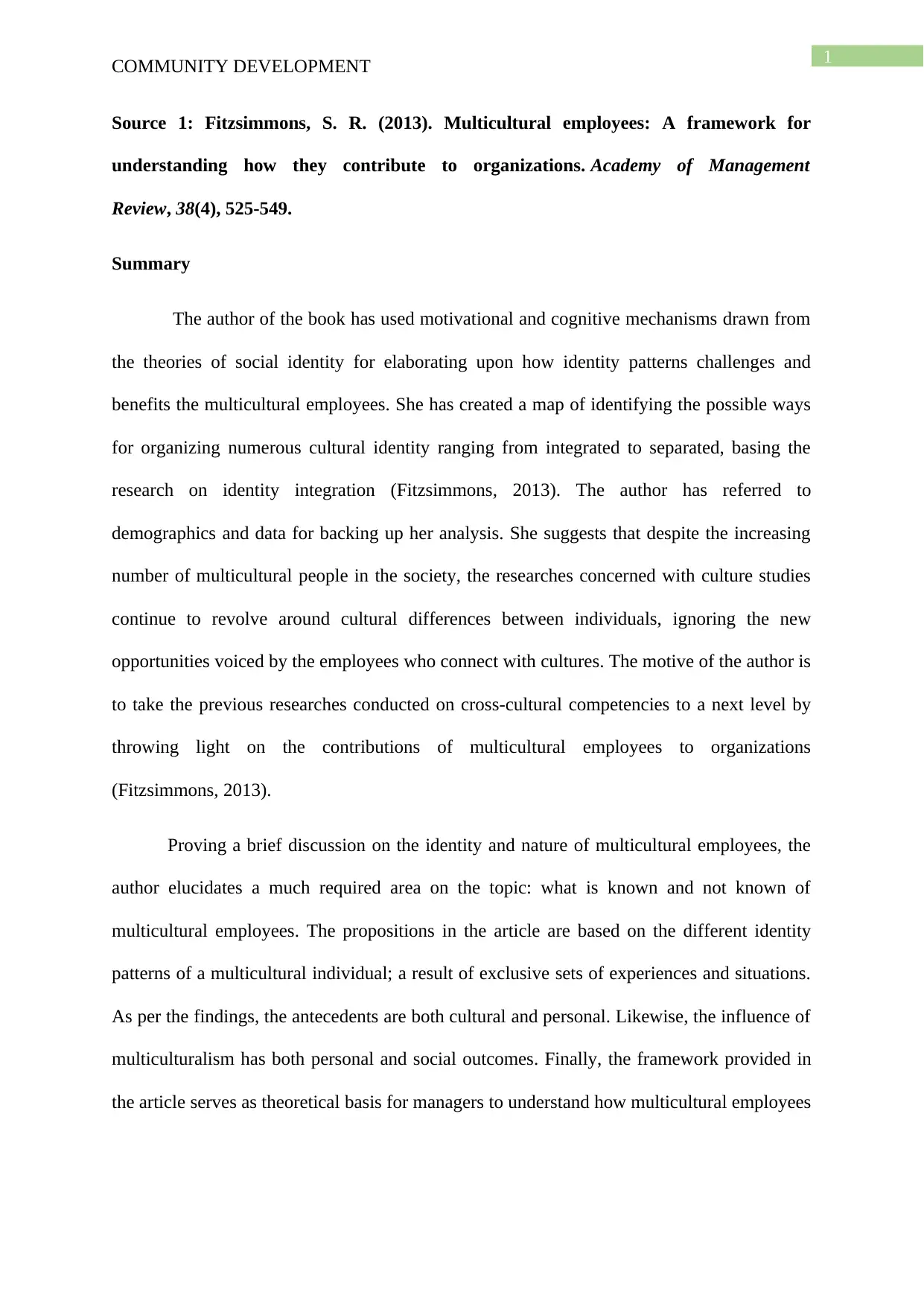
1
COMMUNITY DEVELOPMENT
Source 1: Fitzsimmons, S. R. (2013). Multicultural employees: A framework for
understanding how they contribute to organizations. Academy of Management
Review, 38(4), 525-549.
Summary
The author of the book has used motivational and cognitive mechanisms drawn from
the theories of social identity for elaborating upon how identity patterns challenges and
benefits the multicultural employees. She has created a map of identifying the possible ways
for organizing numerous cultural identity ranging from integrated to separated, basing the
research on identity integration (Fitzsimmons, 2013). The author has referred to
demographics and data for backing up her analysis. She suggests that despite the increasing
number of multicultural people in the society, the researches concerned with culture studies
continue to revolve around cultural differences between individuals, ignoring the new
opportunities voiced by the employees who connect with cultures. The motive of the author is
to take the previous researches conducted on cross-cultural competencies to a next level by
throwing light on the contributions of multicultural employees to organizations
(Fitzsimmons, 2013).
Proving a brief discussion on the identity and nature of multicultural employees, the
author elucidates a much required area on the topic: what is known and not known of
multicultural employees. The propositions in the article are based on the different identity
patterns of a multicultural individual; a result of exclusive sets of experiences and situations.
As per the findings, the antecedents are both cultural and personal. Likewise, the influence of
multiculturalism has both personal and social outcomes. Finally, the framework provided in
the article serves as theoretical basis for managers to understand how multicultural employees
COMMUNITY DEVELOPMENT
Source 1: Fitzsimmons, S. R. (2013). Multicultural employees: A framework for
understanding how they contribute to organizations. Academy of Management
Review, 38(4), 525-549.
Summary
The author of the book has used motivational and cognitive mechanisms drawn from
the theories of social identity for elaborating upon how identity patterns challenges and
benefits the multicultural employees. She has created a map of identifying the possible ways
for organizing numerous cultural identity ranging from integrated to separated, basing the
research on identity integration (Fitzsimmons, 2013). The author has referred to
demographics and data for backing up her analysis. She suggests that despite the increasing
number of multicultural people in the society, the researches concerned with culture studies
continue to revolve around cultural differences between individuals, ignoring the new
opportunities voiced by the employees who connect with cultures. The motive of the author is
to take the previous researches conducted on cross-cultural competencies to a next level by
throwing light on the contributions of multicultural employees to organizations
(Fitzsimmons, 2013).
Proving a brief discussion on the identity and nature of multicultural employees, the
author elucidates a much required area on the topic: what is known and not known of
multicultural employees. The propositions in the article are based on the different identity
patterns of a multicultural individual; a result of exclusive sets of experiences and situations.
As per the findings, the antecedents are both cultural and personal. Likewise, the influence of
multiculturalism has both personal and social outcomes. Finally, the framework provided in
the article serves as theoretical basis for managers to understand how multicultural employees
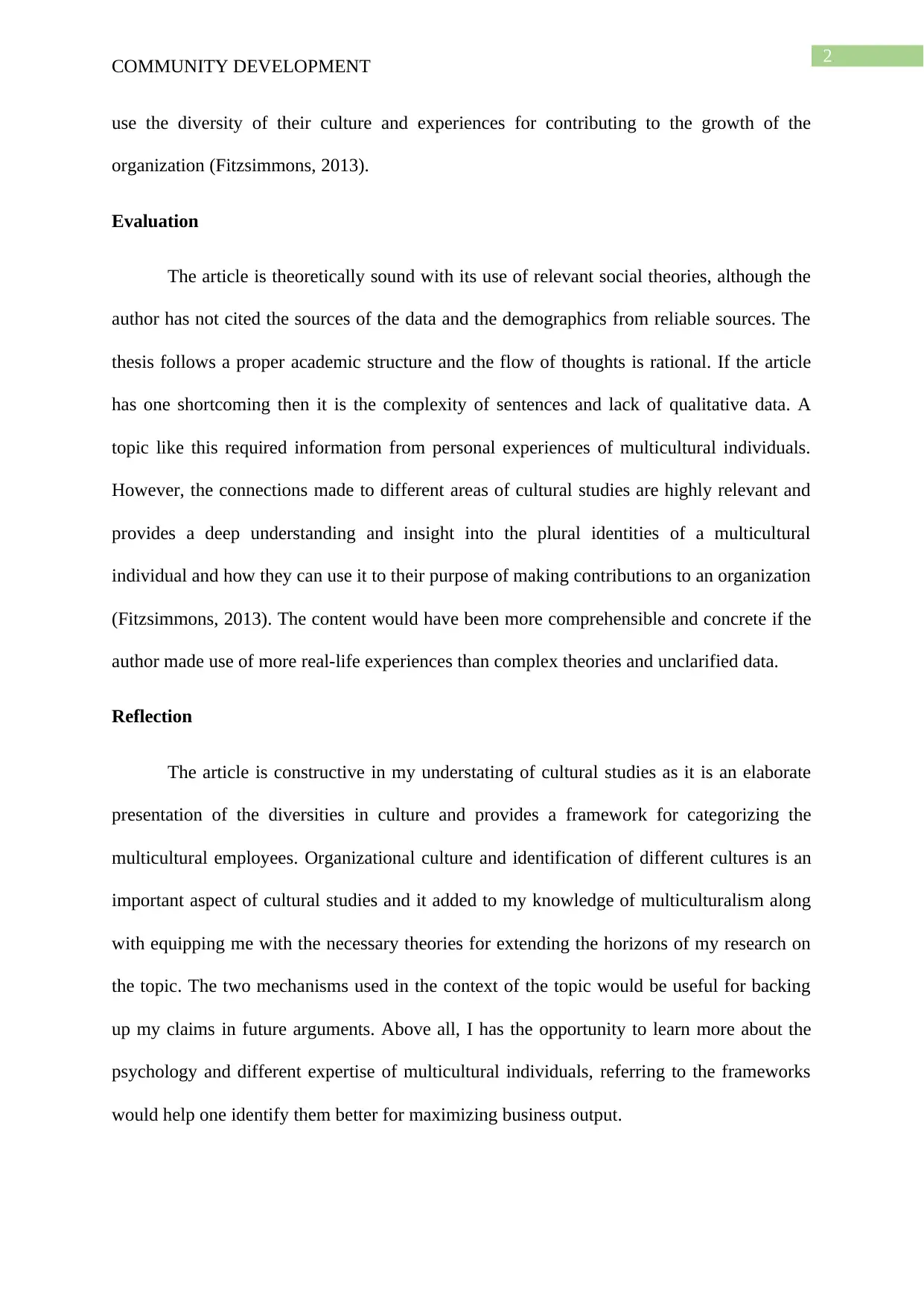
2
COMMUNITY DEVELOPMENT
use the diversity of their culture and experiences for contributing to the growth of the
organization (Fitzsimmons, 2013).
Evaluation
The article is theoretically sound with its use of relevant social theories, although the
author has not cited the sources of the data and the demographics from reliable sources. The
thesis follows a proper academic structure and the flow of thoughts is rational. If the article
has one shortcoming then it is the complexity of sentences and lack of qualitative data. A
topic like this required information from personal experiences of multicultural individuals.
However, the connections made to different areas of cultural studies are highly relevant and
provides a deep understanding and insight into the plural identities of a multicultural
individual and how they can use it to their purpose of making contributions to an organization
(Fitzsimmons, 2013). The content would have been more comprehensible and concrete if the
author made use of more real-life experiences than complex theories and unclarified data.
Reflection
The article is constructive in my understating of cultural studies as it is an elaborate
presentation of the diversities in culture and provides a framework for categorizing the
multicultural employees. Organizational culture and identification of different cultures is an
important aspect of cultural studies and it added to my knowledge of multiculturalism along
with equipping me with the necessary theories for extending the horizons of my research on
the topic. The two mechanisms used in the context of the topic would be useful for backing
up my claims in future arguments. Above all, I has the opportunity to learn more about the
psychology and different expertise of multicultural individuals, referring to the frameworks
would help one identify them better for maximizing business output.
COMMUNITY DEVELOPMENT
use the diversity of their culture and experiences for contributing to the growth of the
organization (Fitzsimmons, 2013).
Evaluation
The article is theoretically sound with its use of relevant social theories, although the
author has not cited the sources of the data and the demographics from reliable sources. The
thesis follows a proper academic structure and the flow of thoughts is rational. If the article
has one shortcoming then it is the complexity of sentences and lack of qualitative data. A
topic like this required information from personal experiences of multicultural individuals.
However, the connections made to different areas of cultural studies are highly relevant and
provides a deep understanding and insight into the plural identities of a multicultural
individual and how they can use it to their purpose of making contributions to an organization
(Fitzsimmons, 2013). The content would have been more comprehensible and concrete if the
author made use of more real-life experiences than complex theories and unclarified data.
Reflection
The article is constructive in my understating of cultural studies as it is an elaborate
presentation of the diversities in culture and provides a framework for categorizing the
multicultural employees. Organizational culture and identification of different cultures is an
important aspect of cultural studies and it added to my knowledge of multiculturalism along
with equipping me with the necessary theories for extending the horizons of my research on
the topic. The two mechanisms used in the context of the topic would be useful for backing
up my claims in future arguments. Above all, I has the opportunity to learn more about the
psychology and different expertise of multicultural individuals, referring to the frameworks
would help one identify them better for maximizing business output.
⊘ This is a preview!⊘
Do you want full access?
Subscribe today to unlock all pages.

Trusted by 1+ million students worldwide
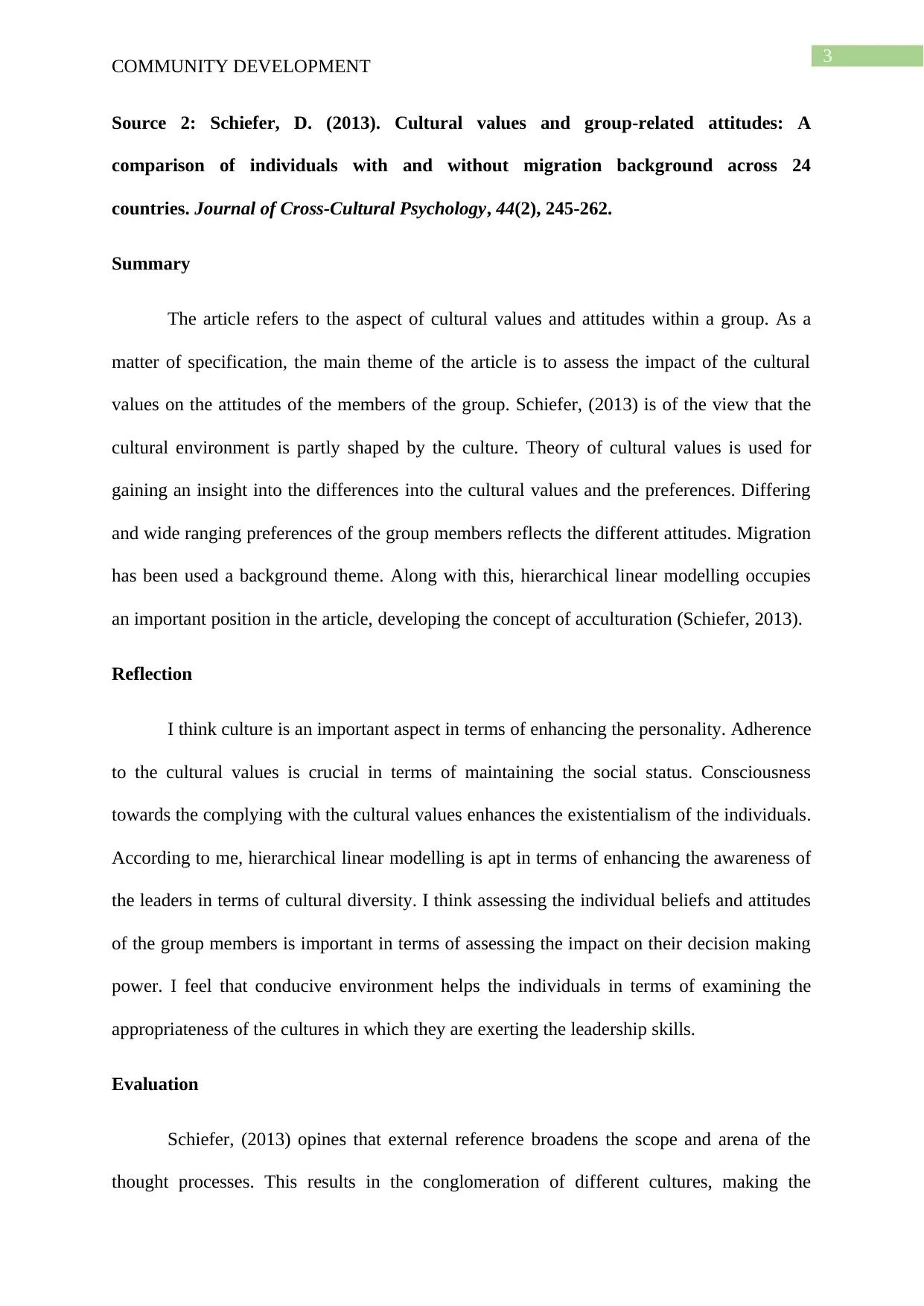
3
COMMUNITY DEVELOPMENT
Source 2: Schiefer, D. (2013). Cultural values and group-related attitudes: A
comparison of individuals with and without migration background across 24
countries. Journal of Cross-Cultural Psychology, 44(2), 245-262.
Summary
The article refers to the aspect of cultural values and attitudes within a group. As a
matter of specification, the main theme of the article is to assess the impact of the cultural
values on the attitudes of the members of the group. Schiefer, (2013) is of the view that the
cultural environment is partly shaped by the culture. Theory of cultural values is used for
gaining an insight into the differences into the cultural values and the preferences. Differing
and wide ranging preferences of the group members reflects the different attitudes. Migration
has been used a background theme. Along with this, hierarchical linear modelling occupies
an important position in the article, developing the concept of acculturation (Schiefer, 2013).
Reflection
I think culture is an important aspect in terms of enhancing the personality. Adherence
to the cultural values is crucial in terms of maintaining the social status. Consciousness
towards the complying with the cultural values enhances the existentialism of the individuals.
According to me, hierarchical linear modelling is apt in terms of enhancing the awareness of
the leaders in terms of cultural diversity. I think assessing the individual beliefs and attitudes
of the group members is important in terms of assessing the impact on their decision making
power. I feel that conducive environment helps the individuals in terms of examining the
appropriateness of the cultures in which they are exerting the leadership skills.
Evaluation
Schiefer, (2013) opines that external reference broadens the scope and arena of the
thought processes. This results in the conglomeration of different cultures, making the
COMMUNITY DEVELOPMENT
Source 2: Schiefer, D. (2013). Cultural values and group-related attitudes: A
comparison of individuals with and without migration background across 24
countries. Journal of Cross-Cultural Psychology, 44(2), 245-262.
Summary
The article refers to the aspect of cultural values and attitudes within a group. As a
matter of specification, the main theme of the article is to assess the impact of the cultural
values on the attitudes of the members of the group. Schiefer, (2013) is of the view that the
cultural environment is partly shaped by the culture. Theory of cultural values is used for
gaining an insight into the differences into the cultural values and the preferences. Differing
and wide ranging preferences of the group members reflects the different attitudes. Migration
has been used a background theme. Along with this, hierarchical linear modelling occupies
an important position in the article, developing the concept of acculturation (Schiefer, 2013).
Reflection
I think culture is an important aspect in terms of enhancing the personality. Adherence
to the cultural values is crucial in terms of maintaining the social status. Consciousness
towards the complying with the cultural values enhances the existentialism of the individuals.
According to me, hierarchical linear modelling is apt in terms of enhancing the awareness of
the leaders in terms of cultural diversity. I think assessing the individual beliefs and attitudes
of the group members is important in terms of assessing the impact on their decision making
power. I feel that conducive environment helps the individuals in terms of examining the
appropriateness of the cultures in which they are exerting the leadership skills.
Evaluation
Schiefer, (2013) opines that external reference broadens the scope and arena of the
thought processes. This results in the conglomeration of different cultures, making the
Paraphrase This Document
Need a fresh take? Get an instant paraphrase of this document with our AI Paraphraser
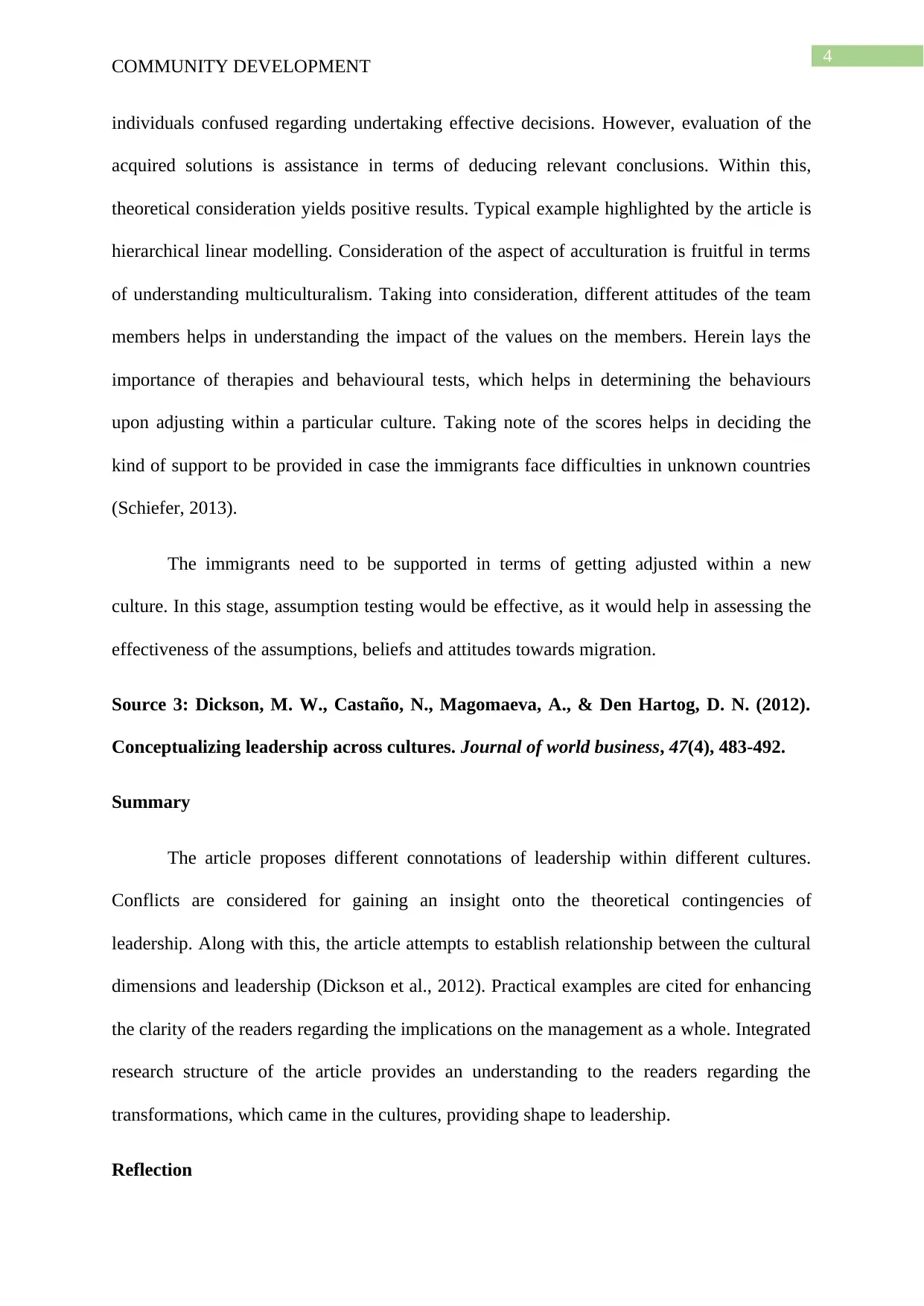
4
COMMUNITY DEVELOPMENT
individuals confused regarding undertaking effective decisions. However, evaluation of the
acquired solutions is assistance in terms of deducing relevant conclusions. Within this,
theoretical consideration yields positive results. Typical example highlighted by the article is
hierarchical linear modelling. Consideration of the aspect of acculturation is fruitful in terms
of understanding multiculturalism. Taking into consideration, different attitudes of the team
members helps in understanding the impact of the values on the members. Herein lays the
importance of therapies and behavioural tests, which helps in determining the behaviours
upon adjusting within a particular culture. Taking note of the scores helps in deciding the
kind of support to be provided in case the immigrants face difficulties in unknown countries
(Schiefer, 2013).
The immigrants need to be supported in terms of getting adjusted within a new
culture. In this stage, assumption testing would be effective, as it would help in assessing the
effectiveness of the assumptions, beliefs and attitudes towards migration.
Source 3: Dickson, M. W., Castaño, N., Magomaeva, A., & Den Hartog, D. N. (2012).
Conceptualizing leadership across cultures. Journal of world business, 47(4), 483-492.
Summary
The article proposes different connotations of leadership within different cultures.
Conflicts are considered for gaining an insight onto the theoretical contingencies of
leadership. Along with this, the article attempts to establish relationship between the cultural
dimensions and leadership (Dickson et al., 2012). Practical examples are cited for enhancing
the clarity of the readers regarding the implications on the management as a whole. Integrated
research structure of the article provides an understanding to the readers regarding the
transformations, which came in the cultures, providing shape to leadership.
Reflection
COMMUNITY DEVELOPMENT
individuals confused regarding undertaking effective decisions. However, evaluation of the
acquired solutions is assistance in terms of deducing relevant conclusions. Within this,
theoretical consideration yields positive results. Typical example highlighted by the article is
hierarchical linear modelling. Consideration of the aspect of acculturation is fruitful in terms
of understanding multiculturalism. Taking into consideration, different attitudes of the team
members helps in understanding the impact of the values on the members. Herein lays the
importance of therapies and behavioural tests, which helps in determining the behaviours
upon adjusting within a particular culture. Taking note of the scores helps in deciding the
kind of support to be provided in case the immigrants face difficulties in unknown countries
(Schiefer, 2013).
The immigrants need to be supported in terms of getting adjusted within a new
culture. In this stage, assumption testing would be effective, as it would help in assessing the
effectiveness of the assumptions, beliefs and attitudes towards migration.
Source 3: Dickson, M. W., Castaño, N., Magomaeva, A., & Den Hartog, D. N. (2012).
Conceptualizing leadership across cultures. Journal of world business, 47(4), 483-492.
Summary
The article proposes different connotations of leadership within different cultures.
Conflicts are considered for gaining an insight onto the theoretical contingencies of
leadership. Along with this, the article attempts to establish relationship between the cultural
dimensions and leadership (Dickson et al., 2012). Practical examples are cited for enhancing
the clarity of the readers regarding the implications on the management as a whole. Integrated
research structure of the article provides an understanding to the readers regarding the
transformations, which came in the cultures, providing shape to leadership.
Reflection

5
COMMUNITY DEVELOPMENT
I think that the article is apt in terms of preparing the employees for emerging as a
leader. An insight into the basic concepts related to leadership cultures, enriches the
knowledge of the readers about the agent, through which they can venture into the path of
leadership. I feel that literary references on leadership cultures provide opportunity to the
readers to gain an insight into the various dimensions of cultural leadership. According to me,
reference to Hofstede’s Cultural dimension is apt in terms of organizing the personality
according to the given culture. I personally feel that consideration of leadership challenges is
effective in terms of assessing their intensity. This assessment is effective in terms of
examining the obstacles into the path of leadership.
Evaluation
Dickson et al., (2012) is of the view that Cross cultural leadership expands the scope
and arena of the thought horizons of the people. Exposing rational approach towards dealing
with the members of the other cultures proves effective in terms of influencing the mindset of
the team members. The article upholds the North American culture, which provides a
practical example to the readers in terms of exposing appropriate leadership skills, abilities
and competencies. If the leaders conduct research about upgrading their leadership skills, it
reflects a planned approach in terms of enhancing the personality. This brings Trait Theory
and Great Man Theory into the discussion. Consciousness towards involving the members
from the other cultures is assistance in terms of assessing the communication skills (Dickson
et al., 2012). Ornamental language while communicating with the team members upgrades
the appearance of the leaders. This indicates getting prospective customers, who would help
in attaining success.
Evaluation of the exposed performance is one of the important traits of the leaders in
terms of upgrading the standards and quality. Maintaining consistency in evaluation brings to
COMMUNITY DEVELOPMENT
I think that the article is apt in terms of preparing the employees for emerging as a
leader. An insight into the basic concepts related to leadership cultures, enriches the
knowledge of the readers about the agent, through which they can venture into the path of
leadership. I feel that literary references on leadership cultures provide opportunity to the
readers to gain an insight into the various dimensions of cultural leadership. According to me,
reference to Hofstede’s Cultural dimension is apt in terms of organizing the personality
according to the given culture. I personally feel that consideration of leadership challenges is
effective in terms of assessing their intensity. This assessment is effective in terms of
examining the obstacles into the path of leadership.
Evaluation
Dickson et al., (2012) is of the view that Cross cultural leadership expands the scope
and arena of the thought horizons of the people. Exposing rational approach towards dealing
with the members of the other cultures proves effective in terms of influencing the mindset of
the team members. The article upholds the North American culture, which provides a
practical example to the readers in terms of exposing appropriate leadership skills, abilities
and competencies. If the leaders conduct research about upgrading their leadership skills, it
reflects a planned approach in terms of enhancing the personality. This brings Trait Theory
and Great Man Theory into the discussion. Consciousness towards involving the members
from the other cultures is assistance in terms of assessing the communication skills (Dickson
et al., 2012). Ornamental language while communicating with the team members upgrades
the appearance of the leaders. This indicates getting prospective customers, who would help
in attaining success.
Evaluation of the exposed performance is one of the important traits of the leaders in
terms of upgrading the standards and quality. Maintaining consistency in evaluation brings to
⊘ This is a preview!⊘
Do you want full access?
Subscribe today to unlock all pages.

Trusted by 1+ million students worldwide
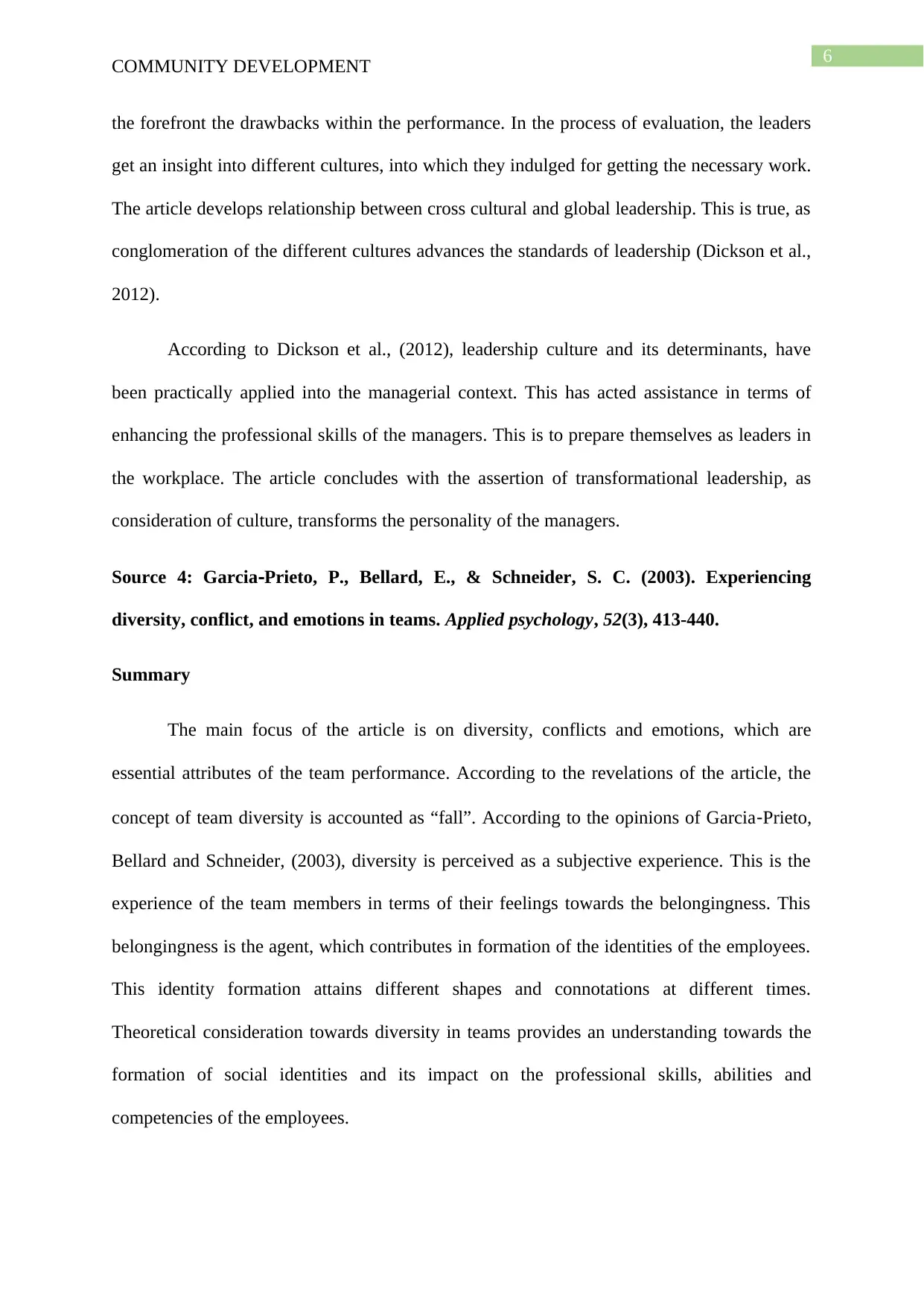
6
COMMUNITY DEVELOPMENT
the forefront the drawbacks within the performance. In the process of evaluation, the leaders
get an insight into different cultures, into which they indulged for getting the necessary work.
The article develops relationship between cross cultural and global leadership. This is true, as
conglomeration of the different cultures advances the standards of leadership (Dickson et al.,
2012).
According to Dickson et al., (2012), leadership culture and its determinants, have
been practically applied into the managerial context. This has acted assistance in terms of
enhancing the professional skills of the managers. This is to prepare themselves as leaders in
the workplace. The article concludes with the assertion of transformational leadership, as
consideration of culture, transforms the personality of the managers.
Source 4: Garcia‐Prieto, P., Bellard, E., & Schneider, S. C. (2003). Experiencing
diversity, conflict, and emotions in teams. Applied psychology, 52(3), 413-440.
Summary
The main focus of the article is on diversity, conflicts and emotions, which are
essential attributes of the team performance. According to the revelations of the article, the
concept of team diversity is accounted as “fall”. According to the opinions of Garcia‐Prieto,
Bellard and Schneider, (2003), diversity is perceived as a subjective experience. This is the
experience of the team members in terms of their feelings towards the belongingness. This
belongingness is the agent, which contributes in formation of the identities of the employees.
This identity formation attains different shapes and connotations at different times.
Theoretical consideration towards diversity in teams provides an understanding towards the
formation of social identities and its impact on the professional skills, abilities and
competencies of the employees.
COMMUNITY DEVELOPMENT
the forefront the drawbacks within the performance. In the process of evaluation, the leaders
get an insight into different cultures, into which they indulged for getting the necessary work.
The article develops relationship between cross cultural and global leadership. This is true, as
conglomeration of the different cultures advances the standards of leadership (Dickson et al.,
2012).
According to Dickson et al., (2012), leadership culture and its determinants, have
been practically applied into the managerial context. This has acted assistance in terms of
enhancing the professional skills of the managers. This is to prepare themselves as leaders in
the workplace. The article concludes with the assertion of transformational leadership, as
consideration of culture, transforms the personality of the managers.
Source 4: Garcia‐Prieto, P., Bellard, E., & Schneider, S. C. (2003). Experiencing
diversity, conflict, and emotions in teams. Applied psychology, 52(3), 413-440.
Summary
The main focus of the article is on diversity, conflicts and emotions, which are
essential attributes of the team performance. According to the revelations of the article, the
concept of team diversity is accounted as “fall”. According to the opinions of Garcia‐Prieto,
Bellard and Schneider, (2003), diversity is perceived as a subjective experience. This is the
experience of the team members in terms of their feelings towards the belongingness. This
belongingness is the agent, which contributes in formation of the identities of the employees.
This identity formation attains different shapes and connotations at different times.
Theoretical consideration towards diversity in teams provides an understanding towards the
formation of social identities and its impact on the professional skills, abilities and
competencies of the employees.
Paraphrase This Document
Need a fresh take? Get an instant paraphrase of this document with our AI Paraphraser

7
COMMUNITY DEVELOPMENT
As per the arguments of (Garcia‐Prieto, Bellard and Schneider, (2003), appraisals and
rewards are effective means for influencing the mindset of the employees. Consideration of
‘black box” enhances the clarity of the readers in terms of cognitive processes, which
determines the performance of the team members.
Reflection
I think diversity is important in terms of expanding the knowledge and thought
horizons of the team members. For this, the managers need to consider the fact that the
employees belong to different socio-cultural background. I think organizing discussions and
open forums, is an “out of the box” approach in terms of enhancing the team diversity. I feel
these discussions prove beneficial in terms of mitigating the instances of conflicts,
discriminations and misunderstandings. I think “falling” and “feeling” relate to the emotions
of the employees. Falling into different categories makes the employees feel that they are a
valuable asset for the company or organization.
Analysis
Falling and feeling are two behavioural approaches of the employees towards the
organizational issues. The categories to which the employees are divided are officially
created by the managers. On the other hand, the categories can be perceived by the
employees according to their skills, competencies and abilities. Theoretical considerations
prove beneficial in terms of gaining an insight into the behavioural psychology of the
employees towards the team into which they are categorized (Garcia‐Prieto, Bellard &
Schneider, 2003). If the employees belonging to the different socio-cultural backgrounds are
involved in the mainstream business decisions, they feel that their opinions and values
matters for achieving success.
COMMUNITY DEVELOPMENT
As per the arguments of (Garcia‐Prieto, Bellard and Schneider, (2003), appraisals and
rewards are effective means for influencing the mindset of the employees. Consideration of
‘black box” enhances the clarity of the readers in terms of cognitive processes, which
determines the performance of the team members.
Reflection
I think diversity is important in terms of expanding the knowledge and thought
horizons of the team members. For this, the managers need to consider the fact that the
employees belong to different socio-cultural background. I think organizing discussions and
open forums, is an “out of the box” approach in terms of enhancing the team diversity. I feel
these discussions prove beneficial in terms of mitigating the instances of conflicts,
discriminations and misunderstandings. I think “falling” and “feeling” relate to the emotions
of the employees. Falling into different categories makes the employees feel that they are a
valuable asset for the company or organization.
Analysis
Falling and feeling are two behavioural approaches of the employees towards the
organizational issues. The categories to which the employees are divided are officially
created by the managers. On the other hand, the categories can be perceived by the
employees according to their skills, competencies and abilities. Theoretical considerations
prove beneficial in terms of gaining an insight into the behavioural psychology of the
employees towards the team into which they are categorized (Garcia‐Prieto, Bellard &
Schneider, 2003). If the employees belonging to the different socio-cultural backgrounds are
involved in the mainstream business decisions, they feel that their opinions and values
matters for achieving success.
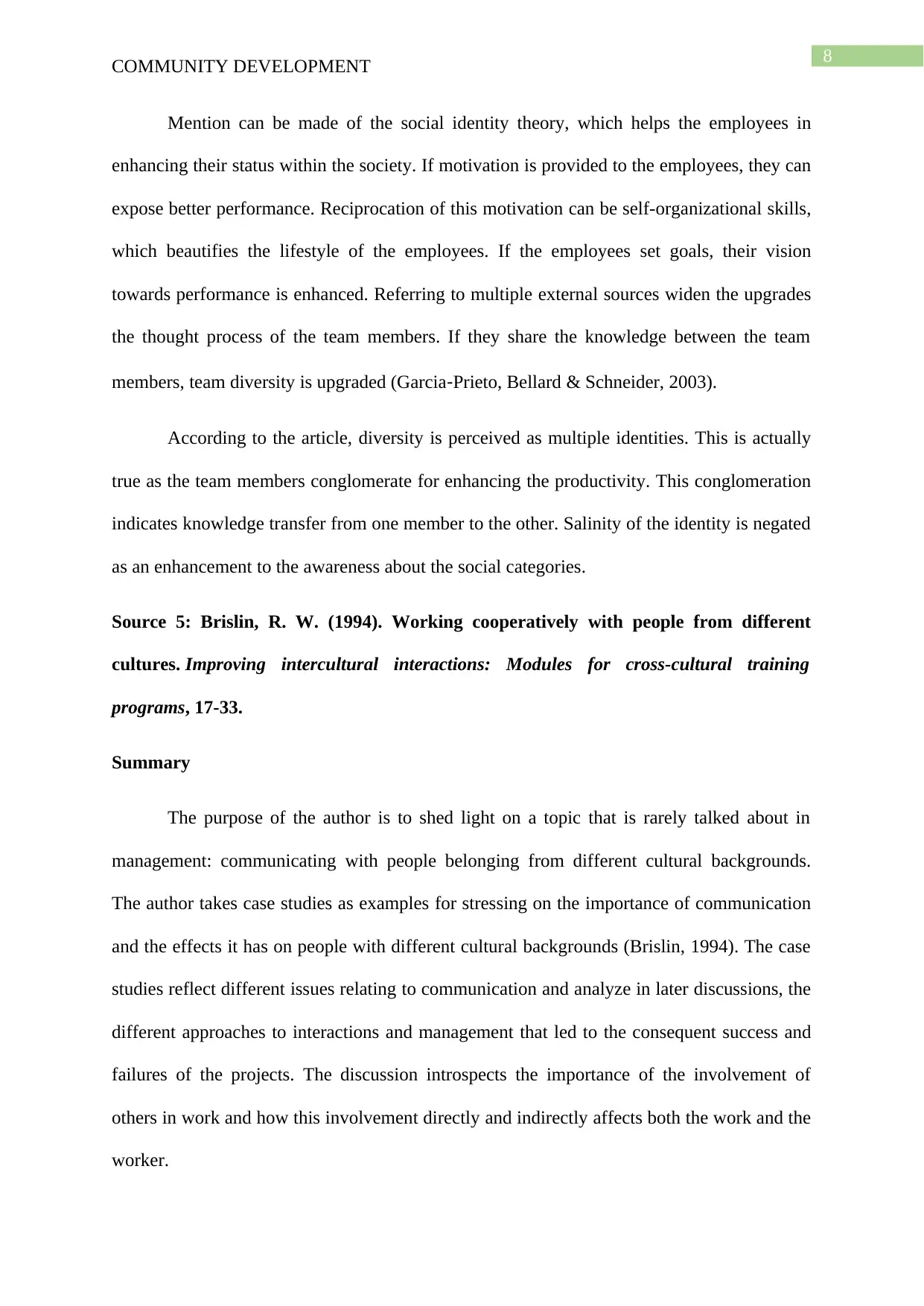
8
COMMUNITY DEVELOPMENT
Mention can be made of the social identity theory, which helps the employees in
enhancing their status within the society. If motivation is provided to the employees, they can
expose better performance. Reciprocation of this motivation can be self-organizational skills,
which beautifies the lifestyle of the employees. If the employees set goals, their vision
towards performance is enhanced. Referring to multiple external sources widen the upgrades
the thought process of the team members. If they share the knowledge between the team
members, team diversity is upgraded (Garcia‐Prieto, Bellard & Schneider, 2003).
According to the article, diversity is perceived as multiple identities. This is actually
true as the team members conglomerate for enhancing the productivity. This conglomeration
indicates knowledge transfer from one member to the other. Salinity of the identity is negated
as an enhancement to the awareness about the social categories.
Source 5: Brislin, R. W. (1994). Working cooperatively with people from different
cultures. Improving intercultural interactions: Modules for cross-cultural training
programs, 17-33.
Summary
The purpose of the author is to shed light on a topic that is rarely talked about in
management: communicating with people belonging from different cultural backgrounds.
The author takes case studies as examples for stressing on the importance of communication
and the effects it has on people with different cultural backgrounds (Brislin, 1994). The case
studies reflect different issues relating to communication and analyze in later discussions, the
different approaches to interactions and management that led to the consequent success and
failures of the projects. The discussion introspects the importance of the involvement of
others in work and how this involvement directly and indirectly affects both the work and the
worker.
COMMUNITY DEVELOPMENT
Mention can be made of the social identity theory, which helps the employees in
enhancing their status within the society. If motivation is provided to the employees, they can
expose better performance. Reciprocation of this motivation can be self-organizational skills,
which beautifies the lifestyle of the employees. If the employees set goals, their vision
towards performance is enhanced. Referring to multiple external sources widen the upgrades
the thought process of the team members. If they share the knowledge between the team
members, team diversity is upgraded (Garcia‐Prieto, Bellard & Schneider, 2003).
According to the article, diversity is perceived as multiple identities. This is actually
true as the team members conglomerate for enhancing the productivity. This conglomeration
indicates knowledge transfer from one member to the other. Salinity of the identity is negated
as an enhancement to the awareness about the social categories.
Source 5: Brislin, R. W. (1994). Working cooperatively with people from different
cultures. Improving intercultural interactions: Modules for cross-cultural training
programs, 17-33.
Summary
The purpose of the author is to shed light on a topic that is rarely talked about in
management: communicating with people belonging from different cultural backgrounds.
The author takes case studies as examples for stressing on the importance of communication
and the effects it has on people with different cultural backgrounds (Brislin, 1994). The case
studies reflect different issues relating to communication and analyze in later discussions, the
different approaches to interactions and management that led to the consequent success and
failures of the projects. The discussion introspects the importance of the involvement of
others in work and how this involvement directly and indirectly affects both the work and the
worker.
⊘ This is a preview!⊘
Do you want full access?
Subscribe today to unlock all pages.

Trusted by 1+ million students worldwide
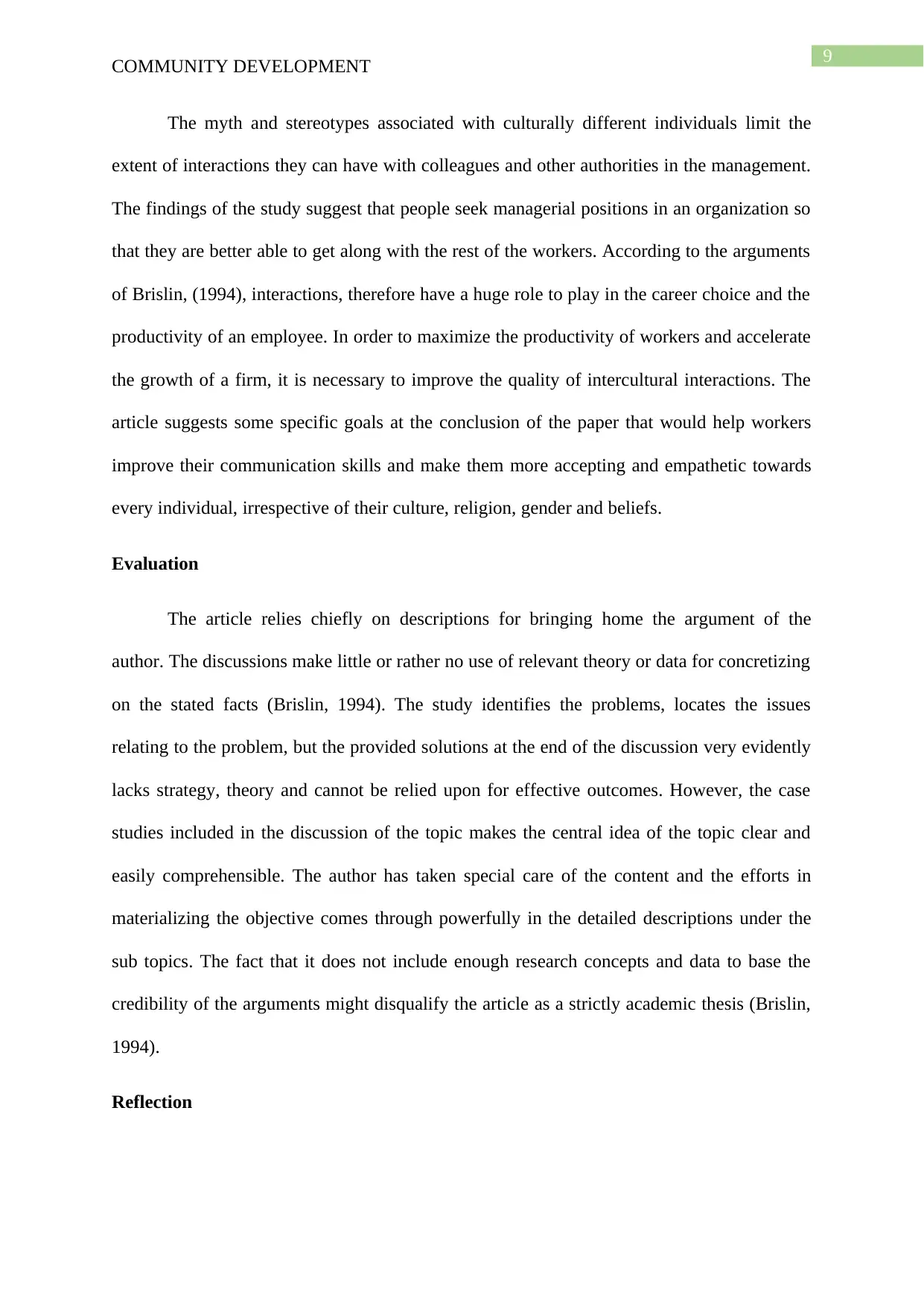
9
COMMUNITY DEVELOPMENT
The myth and stereotypes associated with culturally different individuals limit the
extent of interactions they can have with colleagues and other authorities in the management.
The findings of the study suggest that people seek managerial positions in an organization so
that they are better able to get along with the rest of the workers. According to the arguments
of Brislin, (1994), interactions, therefore have a huge role to play in the career choice and the
productivity of an employee. In order to maximize the productivity of workers and accelerate
the growth of a firm, it is necessary to improve the quality of intercultural interactions. The
article suggests some specific goals at the conclusion of the paper that would help workers
improve their communication skills and make them more accepting and empathetic towards
every individual, irrespective of their culture, religion, gender and beliefs.
Evaluation
The article relies chiefly on descriptions for bringing home the argument of the
author. The discussions make little or rather no use of relevant theory or data for concretizing
on the stated facts (Brislin, 1994). The study identifies the problems, locates the issues
relating to the problem, but the provided solutions at the end of the discussion very evidently
lacks strategy, theory and cannot be relied upon for effective outcomes. However, the case
studies included in the discussion of the topic makes the central idea of the topic clear and
easily comprehensible. The author has taken special care of the content and the efforts in
materializing the objective comes through powerfully in the detailed descriptions under the
sub topics. The fact that it does not include enough research concepts and data to base the
credibility of the arguments might disqualify the article as a strictly academic thesis (Brislin,
1994).
Reflection
COMMUNITY DEVELOPMENT
The myth and stereotypes associated with culturally different individuals limit the
extent of interactions they can have with colleagues and other authorities in the management.
The findings of the study suggest that people seek managerial positions in an organization so
that they are better able to get along with the rest of the workers. According to the arguments
of Brislin, (1994), interactions, therefore have a huge role to play in the career choice and the
productivity of an employee. In order to maximize the productivity of workers and accelerate
the growth of a firm, it is necessary to improve the quality of intercultural interactions. The
article suggests some specific goals at the conclusion of the paper that would help workers
improve their communication skills and make them more accepting and empathetic towards
every individual, irrespective of their culture, religion, gender and beliefs.
Evaluation
The article relies chiefly on descriptions for bringing home the argument of the
author. The discussions make little or rather no use of relevant theory or data for concretizing
on the stated facts (Brislin, 1994). The study identifies the problems, locates the issues
relating to the problem, but the provided solutions at the end of the discussion very evidently
lacks strategy, theory and cannot be relied upon for effective outcomes. However, the case
studies included in the discussion of the topic makes the central idea of the topic clear and
easily comprehensible. The author has taken special care of the content and the efforts in
materializing the objective comes through powerfully in the detailed descriptions under the
sub topics. The fact that it does not include enough research concepts and data to base the
credibility of the arguments might disqualify the article as a strictly academic thesis (Brislin,
1994).
Reflection
Paraphrase This Document
Need a fresh take? Get an instant paraphrase of this document with our AI Paraphraser

10
COMMUNITY DEVELOPMENT
Interaction is a crucial aspect of cultural studies and international interaction has not
been so widely covered by earlier scholars as done by the author of this article. This has
helped me develop a clear idea about the means of effective communication and provided me
with insights into the perspectives and different approaches of culturally different employees.
I feel motivated to read up more on topics concerning intercultural communications and in
my research I would know better to include verifiable data and authentic resource materials to
back up my claims on the topic.
Overview of the annotated bibliography
Topic and the issue
The topic selected for this annotated bibliography is community development. Within
this, aspects like cross cultural communication, cultural leadership, multiculturalism,
conflicts, diversity within the team and cultural values occupy an important position. It can be
said that communication plays an important role in solving the potential conflicts occurring in
every spheres of life including the workplace. Negligence towards the conflicts aggravates
the complexities in the path of development in case of the community people. Along with
this, it also degrades the stability in the workplace relations. As per the opinions of Garcia‐
Prieto, Bellard and Schneider (2003), this makes it difficult for the employees to voice out
their opinions regarding the potential issues, which they are facing. Here, communication is
an effective means for maintaining the workplace diversity.
Selection of journals pertaining to the Question/the problem
Be it a workplace or a community, the employees belong to different socio-cultural
background. This is the reason for selection journals on multiculturalism. Multiculturalism is
bound to result in conflicts, discrimination and harassments. The persons emerging successful
in dealing with these instances transforms into a Leader. This aspect brings Trait Theory and
COMMUNITY DEVELOPMENT
Interaction is a crucial aspect of cultural studies and international interaction has not
been so widely covered by earlier scholars as done by the author of this article. This has
helped me develop a clear idea about the means of effective communication and provided me
with insights into the perspectives and different approaches of culturally different employees.
I feel motivated to read up more on topics concerning intercultural communications and in
my research I would know better to include verifiable data and authentic resource materials to
back up my claims on the topic.
Overview of the annotated bibliography
Topic and the issue
The topic selected for this annotated bibliography is community development. Within
this, aspects like cross cultural communication, cultural leadership, multiculturalism,
conflicts, diversity within the team and cultural values occupy an important position. It can be
said that communication plays an important role in solving the potential conflicts occurring in
every spheres of life including the workplace. Negligence towards the conflicts aggravates
the complexities in the path of development in case of the community people. Along with
this, it also degrades the stability in the workplace relations. As per the opinions of Garcia‐
Prieto, Bellard and Schneider (2003), this makes it difficult for the employees to voice out
their opinions regarding the potential issues, which they are facing. Here, communication is
an effective means for maintaining the workplace diversity.
Selection of journals pertaining to the Question/the problem
Be it a workplace or a community, the employees belong to different socio-cultural
background. This is the reason for selection journals on multiculturalism. Multiculturalism is
bound to result in conflicts, discrimination and harassments. The persons emerging successful
in dealing with these instances transforms into a Leader. This aspect brings Trait Theory and

11
COMMUNITY DEVELOPMENT
Transformational Theory into the discussion. Convincing the community people, in terms of
enhancing the adjustability skills, proves beneficial for upgrading the leadership skills,
abilities and competencies. According to the opinions of Fitzsimmons, (2013), if the
managers organize open forums, discussions and sessions, the employees belonging to other
cultures, gets an opportunity to engage with the mainstream workplace culture. This inclusion
diversifies the workplace culture.
One of the forms of communication is interview with the community people. Here,
mention can be made of the selection of journal articles based on ethical considerations for
preserving the cultural heritage of the community people. Typical example of this is Data
Protection Act (1998), which assists the leaders in maintaining the privacy and security of the
personal data and information of the community people. Consciousness of the people towards
this direction enhances the personality of the leaders. Schiefer, (2013), opines that One-to-
one discussions with the employees, especially with those belonging to the other cultures
reflect multiculturalism in the workplace. Rationality in management of these sessions helps
the managers to venture into the path of cross-cultural leadership.
Pedagogy on Intercultural Studies is one of the other sources from where the journals
on the community development have been selected. One of the other criteria for selecting the
journals is the stereotypical notions, beliefs and cultural issues. Lack of adequate research in
this regard, has deprived the readers about the latest notions regarding community culture.
Negligence in this direction has added to the complexities of the community people. If the
employees are provided training on intercultural studies, their preconceived knowledge
would be enhanced. Moreover, their adjustability skills would be increased, which indicates
the preservation of unity and coordination.
COMMUNITY DEVELOPMENT
Transformational Theory into the discussion. Convincing the community people, in terms of
enhancing the adjustability skills, proves beneficial for upgrading the leadership skills,
abilities and competencies. According to the opinions of Fitzsimmons, (2013), if the
managers organize open forums, discussions and sessions, the employees belonging to other
cultures, gets an opportunity to engage with the mainstream workplace culture. This inclusion
diversifies the workplace culture.
One of the forms of communication is interview with the community people. Here,
mention can be made of the selection of journal articles based on ethical considerations for
preserving the cultural heritage of the community people. Typical example of this is Data
Protection Act (1998), which assists the leaders in maintaining the privacy and security of the
personal data and information of the community people. Consciousness of the people towards
this direction enhances the personality of the leaders. Schiefer, (2013), opines that One-to-
one discussions with the employees, especially with those belonging to the other cultures
reflect multiculturalism in the workplace. Rationality in management of these sessions helps
the managers to venture into the path of cross-cultural leadership.
Pedagogy on Intercultural Studies is one of the other sources from where the journals
on the community development have been selected. One of the other criteria for selecting the
journals is the stereotypical notions, beliefs and cultural issues. Lack of adequate research in
this regard, has deprived the readers about the latest notions regarding community culture.
Negligence in this direction has added to the complexities of the community people. If the
employees are provided training on intercultural studies, their preconceived knowledge
would be enhanced. Moreover, their adjustability skills would be increased, which indicates
the preservation of unity and coordination.
⊘ This is a preview!⊘
Do you want full access?
Subscribe today to unlock all pages.

Trusted by 1+ million students worldwide
1 out of 15
Related Documents
Your All-in-One AI-Powered Toolkit for Academic Success.
+13062052269
info@desklib.com
Available 24*7 on WhatsApp / Email
![[object Object]](/_next/static/media/star-bottom.7253800d.svg)
Unlock your academic potential
Copyright © 2020–2025 A2Z Services. All Rights Reserved. Developed and managed by ZUCOL.




